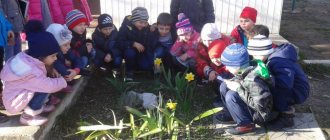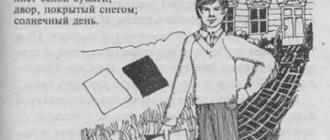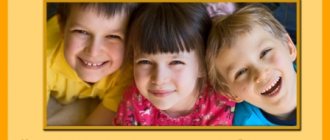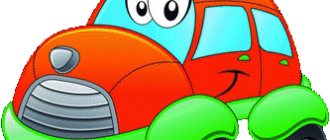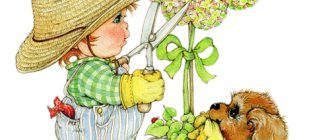Experiments for children of the preparatory group in kindergarten
Interesting experiments for children
In the preparatory group, conducting experiments should become the norm; they should be considered not as entertainment, but as a way to familiarize children with the world around them and the most effective way to develop thought processes.
Experiments allow you to combine all types of activities and all aspects of education, develop observation and inquisitiveness of the mind, develop the desire to understand the world, all cognitive abilities, the ability to invent, use non-standard solutions in difficult situations, and create a creative personality. Some important tips: 1. It is better to conduct experiments in the morning, when the child is full of strength and energy; 2. It is important for us not only to teach, but also to interest the child, to make him want to gain knowledge and do new experiments himself. 3. Explain to your child that you cannot taste unknown substances, no matter how beautiful and appetizing they look; 4. Don’t just show your child an interesting experience, but also explain in a language he understands why this happens; 5. Do not ignore your child’s questions - look for answers to them in books, reference books, and the Internet; 6. Where there is no danger, give the child more independence; 7. Invite your child to show his favorite experiments to his friends; 8. And most importantly: rejoice in your child’s successes, praise him and encourage his desire to learn. Only positive emotions can instill a love for new knowledge. Experience No. 1. "Vanishing Chalk"
For a spectacular experience, we will need a small piece of chalk. Dip chalk into a glass of vinegar and see what happens. The chalk in the glass will begin to hiss, bubble, decrease in size and soon disappear completely. Chalk is limestone; when it comes into contact with acetic acid, it turns into other substances, one of which is carbon dioxide, which is rapidly released in the form of bubbles. Experience No. 2. "Erupting Volcano"
Necessary equipment: Volcano: - Make a cone from plasticine (you can take plasticine that has already been used once) - Soda, 2 tbsp. spoons Lava: 1. Vinegar 1/3 cup 2. Red paint, a drop 3. A drop of liquid detergent to make the volcano foam better; Experience No. 3. "Lava - lamp"
Needed: Salt, water, a glass of vegetable oil, several food colors, a large transparent glass. Experience: Fill a glass 2/3 full with water, pour vegetable oil into the water. Oil will float on the surface. Add food coloring to water and oil. Then slowly add 1 teaspoon of salt. Explanation: Oil is lighter than water, so it floats on the surface, but salt is heavier than oil, so when you add salt to a glass, the oil and salt begin to sink to the bottom. As the salt breaks down, it releases oil particles and they rise to the surface. Food coloring will help make the experience more visual and spectacular. Experience No. 4. "Rain Clouds"
Children will be delighted with this simple fun that explains to them how rain falls (schematically, of course): first the water accumulates in the clouds and then spills onto the ground. This “experience” can be carried out in a natural history lesson, in a kindergarten, in an older group, and at home with children of all ages - it fascinates everyone, and the children ask to repeat it again and again. So, stock up on shaving foam. Fill the jar with water about 2/3 full. Squeeze the foam directly on top of the water until it looks like a cumulus cloud. Now use a pipette to drop colored water onto the foam (or better yet, trust your child to do this). And now all that remains is to watch how the colored water passes through the cloud and continues its journey to the bottom of the jar. Experience No. 5. "Red Head Chemistry"
Place finely chopped cabbage in a glass and pour boiling water over it for 5 minutes. Strain the cabbage infusion through a cloth. Pour cold water into the other three glasses. Add a little vinegar to one glass, a little soda to the other. Add the cabbage solution to a glass with vinegar - the water will turn red, add it to a glass of soda - the water will turn blue. Add the solution to a glass of clean water - the water will remain dark blue. Experience No. 6. "Blow up the balloon"
Pour water into a bottle and dissolve a teaspoon of baking soda in it. 2. In a separate glass, mix lemon juice with vinegar and pour into a bottle. 3. Quickly place the balloon on the neck of the bottle, securing it with electrical tape. The ball will inflate. Baking soda and lemon juice mixed with vinegar react to release carbon dioxide, which inflates the balloon. Experience No. 7. "Colored milk"
Needed: Whole milk, food coloring, liquid detergent, cotton swabs, plate. Experience: Pour milk into a plate, add a few drops of different food colors. Then you need to take a cotton swab, dip it in the detergent and touch the swab to the very center of the plate with milk. The milk will begin to move and the colors will begin to mix. Explanation: The detergent reacts with the fat molecules in the milk and causes them to move. This is why skim milk is not suitable for the experiment.
We recommend watching:
Experiments for children aged 2-3 years Experimental activities in kindergarten. Junior group Direct educational activities on experimentation in the middle group Integrated cognitive cycle lesson in the senior group on the topic: Winter
Similar articles:
Lesson notes on folk applied arts in the preschool group of preschool educational institutions


